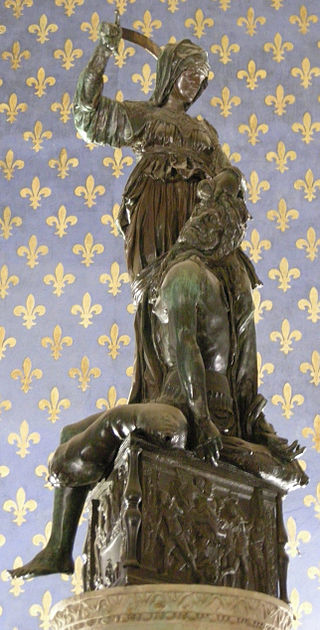If you ignore the crowds around the replica of Michelangelo's David in the Piazza della Signoria in Florence, there is an abundance of other great sculpture, but the one that doesn't catch your eye is perhaps the greatest of all. Donatello's Judith and Holofernes (in replica) looks small, insignificant, almost unappealing, sandwiched as it is between the two colossi of David and Ammannti's Neptune fountain. It's bronze surface appears dingy and weathered in comparison with their gleaming whiteness; the patina makes it difficult to focus on the subject matter, and the complex composition with its restless surface would surely be better seen on a level, rather than positioned high up on a plinth. The work itself has an introspection, a centripetal dynamic, which is no match for the 'look at me' nudes on either side. Take time to head into the Palazzo Vecchio and look at the original. Take time to imagine how it would have once looked, gilded, standing in the Medici garden alongside Donatello's own version of David.
There is a quiet radicalism about this sculpture which is easily ignored by a 21st century viewer. The base is a cushion, on which Holofernes sits, his weight rendered visible in the sag beneath him. Donatello had used the device before: his St Mark (c.1411-13) stands on a small and obviously rather firm pillow, but the effect there is tentative. Here the yielding softness is palpable and the realism is taken a stage further with the positioning of Holofernes' leg dangling limply over the side of the plinth. It's a deliberate attempt to break the barriers between reality and art, an invasion of the viewers' world, like Mantegna's swags of fruit and architectural framing. Time and again in his reliefs Donatello showed that he was interested in the illusionistic possibilities of perspective to create naturalistic space, playing with the full range of depths which the relief surface allowed, but this is all the more striking for being in 3D. Whereas fifteenth century painters stuck a tentative saint's toe towards the viewer, Donatello shoves a whole limb through the sculptural fourth wall.
The tight, columnar composition is deceptively simple, and only really appreciable in the round. It manages to combine a strong vertical emphasis, which begins with Holofernes' limp arms, with a downward spiral from the tip of Judith's sword; suggesting both the act of killing and the future death whilst showing neither. The complex drama of the whole narrative is explicit in the entwined bodies, with Holofernes positioned between Judith's legs and her fingers almost delicately entwined in his hair. But Donatello's Judith is neither the bloodthirsty assassin nor the eroticised princess that most artists chose to portray. She is chaste, veiled, swathed in draperies which almost hide her body; take away the sword and she could be Mary cradling a dead Christ. There are plenty of early Renaissance tropes here: an idealised male nude, extravagant detail (the pendant on Holofernes back), Latin inscription and a complex symbolism which has given art historians plenty to hypothesise about. But they remain secondary to the figures and their treatment.
Judith and Holofernes illustrates why Donatello is so good: narrative and character are what matter to him above all else. Every piece by Michelangelo is primarily a triumph of the artist's skill; every Donatello is about making the subject breath. David (c.1440s) as a beautiful young boy trying to grasp the enormity of what he has done; Zuccone (c.1423) and Jeremiah (c.1423) as men prematurely aged by the burden of their prophecy; perhaps most famously The Penitent Magdalene (c.1455) emaciated, haggard, yet eyes burning with belief. Even in the early Santa Croce Crucifixion (c.1409), generally agreed to be by Donatello, and according to Vasari's gossipy version, ridiculed by Brunelleschi as resembling a 'ploughman'; even here you can see an attempt to show a real man in pain. Wood, bronze or marble, relief or statue Donatello pushed the boundaries - technically, emotionally and aesthetically. And he pushed them so far that you have to look forward all the way to Rodin at the end of the 19th century to find another sculptor with the same range and psychological depth.



No comments:
Post a Comment